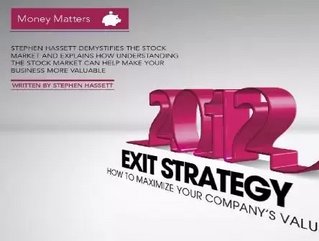Exit Strategy: How to Maximize Your Company's Value

Click here to read this article in the March issue of Business Review USA!
Written by Stephen Hassett
You’ve spent years building your business and for whatever reason you are ready to sell it. How do you maximize value? Unfortunately, you may be too late. The value creation process needed to start years ago and short-term fixes may actually make things worse. In order to understand why, it helps to start with the stock market.
When many people think of the stock market, they conjure up images of the 1987 movie, Wall Street complete with its crazy co-star, Charlie Sheen. The truth is far from that. Over long term, the market is in fact, not only rational, but it is easy to understand and almost reptilian in response to readily observable factors. The ways of the market are actually simple and straight forward.
To maximize value you want to have sustainable growth and strong cash flow (earnings). It’s that simple. Instead, many people believe the market is almost arbitrary in assigning values. This leads to bad decision making.
One of the main metrics used to compare values between companies is the P/E ratio, which is simply the value of a company divided by its earnings or the share price divided by its earnings per share. If Company A earns $1.50 per share and its stock price is $15.00 then its P/E ratio is 10. If Company B’s stock price is $30 with the same $1.50 in earnings, then its P/E ratio is 20. This implies that for every ten cents per share that Company A adds it will increase its share price by $1.50, while Company B will increase by $3.00. So obviously you want a high P/E ratio, but how? Why aren’t all dollars the same? Why do some companies command a premium?
Differences in the P/E ratio among healthy companies are driven by one thing – expected long-term growth. (You can learn why and about the model behind this in my book, the “The Risk Premium Factor.”)
The relationship is simple – if your expected growth rate increases so does your P/E ratio and your company becomes more valuable. Likewise, slower growth means a lower P/E ratio. Before going any further, it helps to understand what this growth rate means. It is the expected long-term growth in earnings or cash flow, meaning that on average your investor expects the company to grow at this rate forever. Now here is a mistake that many people, even sophisticated investors, make. They don’t grasp that the growth rate is based on investors’ long-term expectations for the future, not what you did last year and not what you expect to do next year. Misunderstanding this can cause serious problems.
If you have grown earnings over the past several years by cutting cost and not growing revenue, investors are not going to be convinced you have a long-term growth story because you can’t cut costs forever. In order to have a good growth story, you need to show the ability to grow the top line and the bottom line.
Investors have to believe your story. You won’t get credit for growth, if they don’t believe it’s sustainable. Creating the growth story takes time, which is why starting when you’re ready to sell is too late.
If you want to show bottom line growth by beginning to cut costs a year or two before you’re ready to sell, rather than creating a growth story, you many destroy value by making decisions that sap your top line growth. Here’s how.
Let’s assume your business has been growing at a modest 5 percent per year and earns $1 million. If a would-be buyer believed that you could sustain that growth, based on my model, we could expect them to pay you 20 times or $20 million. Rather than take the $20 million, you decide to boost earnings by cutting sales expense by $500,000 and the result boosts your bottom-line at the expense of revenue growth which drops to zero. The savvy investor will see that you have a healthy $1.5 million in earnings but no growth. Since you can’t cut costs forever, they may assume your long-term growth rate is zero. Based on my model, the result is that your P/E ratio drops to 10, so the value of your business actually drops to $15 million despite the increase in profits.
Not only do investors value growth, but they are smart. M&A professionals know the difference between sustainable and unsustainable growth. Simple common sense says the best way to create that growth story is to start early and invest wisely. Less wide known is the fact that your growth story is one of the most important drivers of value.
About the Author: Stephen D. Hassett is a corporate development executive with Sage North America, a subsidiary of The Sage Group plc, a leading global supplier of business management software and services and author of "The Risk Premium Factor: A New Model for Understanding the Volatile Forces that Drive Stock Prices" (Wiley 2011).






